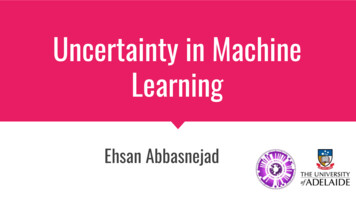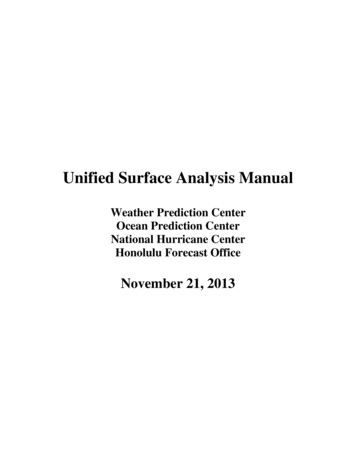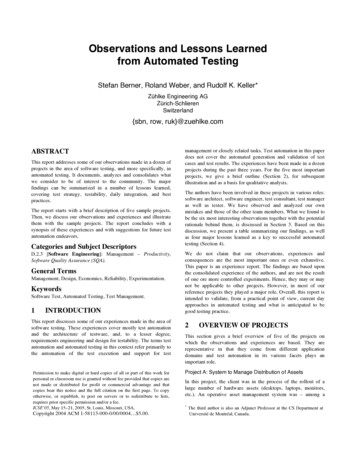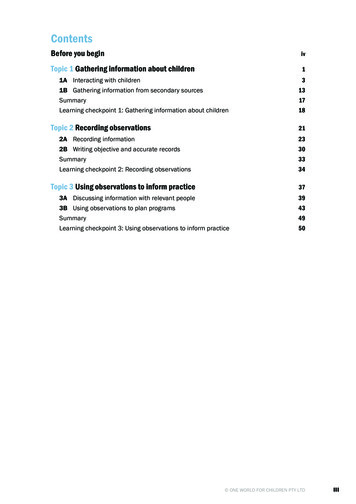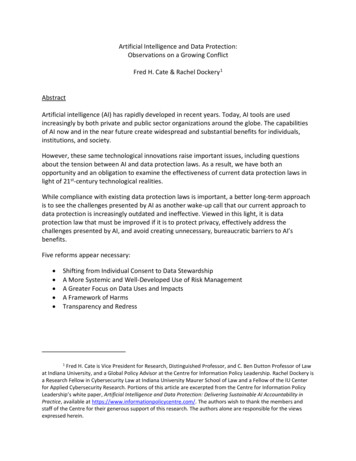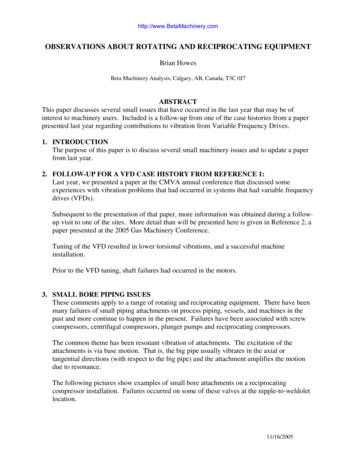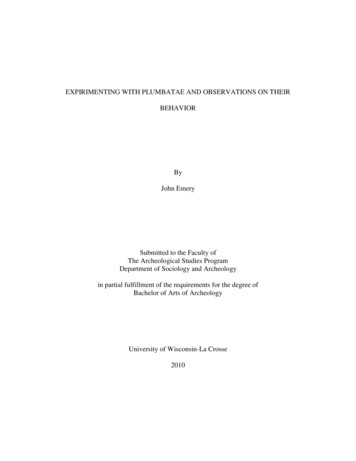
Transcription
EXPIRIMENTING WITH PLUMBATAE AND OBSERVATIONS ON THEIRBEHAVIORByJohn EmerySubmitted to the Faculty ofThe Archeological Studies ProgramDepartment of Sociology and Archeologyin partial fulfillment of the requirements for the degree ofBachelor of Arts of ArcheologyUniversity of Wisconsin-La Crosse2010
Copyright 2010 by John EmeryAll rights reservedii
EXPIRIMENTING WITH PLUMBATAE AND OBSERVATIONS ON THEIRBEHAVIORJohn Emery, B.A.University of Wisconsin-La Crosse, 2010This study looked at the behavior of the plumbata, a unique Roman throwing weapon. This wasdone through the replication of weapon heads, shafts, and flights based off of previous researchand through the incorporation of historical pictorial representations. The objective of this studywas to include the important element of time and practices that had not previously beenaccounted for in earlier studies. This study also looked at near exact replication of the weaponsbased solely from the pictorial representations of historical manuscripts. This had beenmentioned by previous researchers but had never been carried out. Basic results were that theweapon does indeed improve in range and consistency of behavior in flight providing increasingsmooth flights and a max range of over 200 ft. The result of the picture based weapons was thatthey did not perform nearly to the ability of the non-pictorial based weapons.iii
I would like to acknowledge my Grandfather, without whom, I would not have been able to domost of this study. Thanks to him for his guidance and patience. Next to whom I owe gratitude isJohn Eagle and his colleagues who provided the groundwork with which I was able to base mystudies and to use as a springboard for the next steps. Thanks to Dr. David Anderson and Dr.Joseph A. Tiffany for providing comments, guidance and ideas in my research. Finally thanks toRev. Deris Rice, Rev. Laura Hoglund and all my friends and family who supported me withencouragements and interest in my work.iv
INTRODUCTION: A NEW WEAPON IN THE OLD WORLDThe Roman military has always been known for the power and ability of their infantry. As goodas they were in close order combat, they always held an even more significant advantage overtheir foes. That advantage is the training that legionnaires and soldiers had in the effective use ofhand launched missile weapons. Throughout most of its military history the army of Rome usedspecialized javelins to give their infantry an added punch. From the beginning of the republic tothe end of the empire, the Romans, almost without exception, armed their main battle infantrywith some kind of hand launched missile weapon.While one could write volumes on all the forms of missile weapons with which Romeequipped her soldiers, there is one specific weapon that is of interest to scholars andarcheologists. This weapon appears in the historical and archeological record around the fourthcentury A.D. This weapon has been called by historians and archeologists the “Plumbata”(Bishop and Coulston 2006:200). However, while the archeological remains have been examinedand the historical accounts make mention of it, the plumbatae are relatively obscure.Yet even as obscure as this weapon is, there are still many aspects of the weapon that canbe studied through an active process of experimentation. By taking what is known, historicalaccounts, pictorial representations, and the archeological remains, then combining it withreasoned assumptions about Roman equipment, a picture of how the weapon may have lookedand behaved in Roman hands can be compiled. This can be used to make a series of experimentsthat look at the missing elements of the weapon characteristics.
Therefore using direction from other studies and information from history andarcheology, a series of experiments was designed to study the behavior and characteristics of theweapon. The reproductions based off of archeological remains and pictorial representations ofparticular head shapes gave a basis to discern how or if the particular weapons differed. Thepractice and throwing of the weapon consistently over a period of weeks allowed for the elementof training and improvement as would have been seen with the Romans. Finally the observationof the weapons in flight gave the best evidence of how the weapons behaved from the point ofrelease to the point of impact, allowing real time examination of this unique Roman weapon.WEAPON AND EQUIPMENT CHANGES AT THE PERIOD OF PLUMBATAEMERGENCE, HISTORICAL SOURCES, AND ARCHEOLOGICAL MATERIALThe approximate time that the plumbata begins to appear is the fourth and following centuriesA.D. This period in Roman history saw a steady decline of the greatest power of the Romanmilitary. Rome had been through over a century and a half of political turmoil, rapid imperialsuccessions, military strong-arming, and frequent civil wars. As if this was not enough, Romesimultaneously suffered from barbarian raids and incursions on her boarders. Only the ascensionof Diocletian brought a much needed respite; but once he retired, Rome slid back into periods,albeit less frequent and intense, of political and military strife (Southern 2006).By the time of the plumbata‟s appearance, at least archeologically, the Roman militaryhad seen a great decline. The historian Vegetius mentions the abandonment of armor because of“negligence and sloth” (Phillips 1944:25). While this is probably not a universal and should notbe taken uncritically, it does signify the idea that change has occurred to the once greatestmilitary force in the world (Elton 1996: 110-114).2
The changes of the attitudes of the soldiers, at least mentioned by Vegetius, are not justinherent in the camp. There were changes on the field of battle that were to have far greaterreaches in the military capability of Rome. In many ways, cavalry was superseding the infantryand the infantry were less and less the principle arm on the battlefield, being relegated to supportroles (Phillips 1944:2). The Plumbata, because of its presumed range, (Eagle 1991) may reflecttactical desire or necessity for added range on the part of the battle line infantry.While there were several other types of hand thrown ranged weapons (Elton 1996:108)the plumbata is unique. One peculiarity is that the weapon has a comparatively small head inrelation to other contemporary weapons such as the spiculum, or the much more famousthrowing weapon, the pilum (Elton 1996:109). Of the various ranged weapons of this time, itappears that the plumbata is used as a longer ranged weapon, thrown at a comparatively longerrange, with several, Vegetius mentions, being thrown in succession (Phillips 1944:24). UponExhaustion of the light weapons, the “common missile weapons” (Phillips 1944:24) are thenreleased. Therefore, from a principle historical source it appears that the plumbata is a kind ofiron drizzle, before the steel rain.Historically, there is comparatively little written about the plumbata. The few sources thatare available mention only briefly the weapon. One important source is the Historian, FlaviusVegetius Renatus. He has already been spoken of several times, but he is an important figure inboth the study of the plumbata as well as later Roman military history. His statement on theweapon is brief, but it provides insight as to the impetus of the so called “loaded Javelin” whichhe also calls “Martiobarbuli” (Phillips 1944:23). As an important aspect of his statements aboutthe weapon, he notes their use by the famous Illyrian Legions that became distinguished mainlyby their “extraordinary dexterity and skill in the use of these weapons” (Phillips 1944:23).3
Not only does this provide a historical mentioning of the weapon, it also gives a possiblehistorical indication as to the appearance of the weapon, prior to archeological findings. Vegetiusmentions that the particular Illyrian legions “supported for a long time the weight of all the warsand distinguished themselves so remarkable that the Emperors Diocletian and Maximian on theirascension honored them with the titles of Jovian and Herculean and preferred them before all theother legions.” (Phillips 1944:23).If Vegetius‟s statement about the Illyrian legions is relevant to his discussion of theweapon, then it is possible that it could place it back into the late third century A.D. or even themid third century A.D., significantly prior to the archeological finds. However, given itsplacement, it could only be an implanted anecdote about the prowess of these particular legions.Whether or not his statement about the legions is relevant to his discussion about the loadedjavelin is more a matter of textual criticism. But, because he does place that statement within thecontexts of his discussion of the weapon, the statement should at least be noted and givenconsideration.Vegetius, for his discussion on the relative importance of the weapon, does not provideany dimensions as to the build and composition of the weapon. For that, there is the fourthcentury A.D. De Rebus Bellicis, written by an anonymous author (Elton 1996:118). De RebusBellicis is a manual on warfare and aspects of warfare ranging from military finance, fieldequipment, navy, and even strategy (Hassall and Ireland 1979).Like Vegetius, De Rebus Bellicis‟s discussion on the plumbata is relatively short. UnlikeVegetius however, the anonymous author gives specific details as to how the weapon should bebuilt. In the translation, it mentions two different types of Javelin. The first mentioned, andprobably most damaging, is the “tribolatae” (Ireland 1979:10). Tribolatae is translated as the4
“Caltrop” javelin (Ireland 1979:30). This, according to the specifications of De Rebus, is themost complex.Now it is made if a piece of wood fashioned like an arrow, to which, is carefullyfixed an iron tip worked into the shape of a hunting spear, with the tubular end ofthe blade extended a little way: above this, with a short gap left in between, spikeslike caltrops project, soldered on with lead. And at the lower end of the javelin arefixed flights to give speed, with enough space left above these flights, of course,for the fingers of the holder to be able to grasp. (Ireland 1979:30).This is verbatim from the translation describing the weapon specifications. While there havebeen some plumbata found that have barbed heads (see Figure 3 and 6), such as those ofWroxeter (Musty and Baker 1974), it is so far unknown whether there are any that resembleexact forms to which De Rebus alludes. In any case, the relative Fourth Century AD date of DeRebus is approximately in line with the archeological findings of these particular weapons,which also begin showing up at around this era as well. (Bishop and Coulston 2006:200).There is a second type of javelin that is mentioned in De Rebus. This weapon appears tobe a simpler style called “Mamillatae” (Ireland 1979:10) or “Breasted”:A shaft, nicely long and straight, will have fitted to one of its ends a piece of iron,round in section and tapering to a point, with a lead weight and flights attached atthe same points as in the „caltrop‟ type, so that the bulbous weapon, assisted bythe weight of the lead and the swiftness of the flights, will be powerful enough topenetrate easily the enemy‟s shields and similar obstacles. (Ireland 1979:30-31)This particular weapon, given the description, seems to be of a more straight forward nature. Itapparently does not deal with the extra barbs or caltrops and has the specific purpose of defensepenetration in mind (again see Figure 3 and 6). The lead weight and head are consistent withvarious archeological finds and certain weapons that have been found might have the penetrativequalities that this particular section of De Rebus mentions, even if they may not fit the idealexactly (Bennett 1991).5
Another very important aspect of De Rebus Bellicis is the fact that it has pictures inaddition to descriptions of approachable detail. The plates that are provided in Hassall andIreland (Hassal and Ireland 1979:Plate IX) are unfortunately only black and white, butnonetheless they still provide respectable visual clarity to discern some of the various forms ofthe plumbata weapons, either the Tribolatae or the Mamillatae and their attributes. Since theshafts of the plumbata remains are non-extant, the pictorial description of De Rebus becomes anintegral part in the understanding of the unique weapons.However, it is still a question as to whether the pictures of De Rebus are accurate in theirpractical representation. By this, one needs to ask if there are truly weapons that can be foundthat exactly match both the description and pictorial representation. Or whether the weapons arethat of an idealized nature, only presenting a theoretical, if not romantic, representation that maynot even be a practical weapon if constructed to exact specifications. Like Vegetius‟s statement,deciding that matter would be of a nature that is outside the parameters of this study. However, itis a note worth mentioning in that given the sometimes fluid nature of interpretation ofrepresentations, both pictorial and literary, that one should not commit to assumed particulars.To supplement the historical material of the weapon, there are material remains of theweapon in good enough condition to describe it, according to historical descriptions, asplumbata(e). Over the years there have been several points that have been found in Britain(Musty and Baker 1974), several unique heads that have been discovered in what is now theRepublic of Georgia (Bennett 1991), as well as others that have been found throughout Romanoccupied territory (Bishop and Coulston 2006). Each of these remains have heads showing bothdifferences, particularly the Georgian heads, but also similarities. Emphasizing prominently thesimilarities, most have a type of weight soldered to a shank. Except the Georgian heads, they6
have barbs of some degree or another (Bishop and Coulston 2006). Finally, and most universallythey are comparatively short to other weapons (Elton 1996).The data that features prominently are the barbed remains from Wroxeter, Shropshire,conducted by Musty and Baker (Musty and Baker 1974). Here, they mention the barbed headswith a narrow shank with a lead mass enclosing a socket (Musty and Baker 1974). In their shortarticle they give some dimensions of the head, twelve centimeters, and tried to figure fordissimilar material (Musty and Baker 1974) which would constitute a shafted throwing weapon.As mentioned was slightly dissimilar, Plumbatae from Pitsunda by Julian Bennett showanother group of these weapons. Where they were found is now in the area of the Republic ofGeorgia. Therefore, it shows a wide ranging use of the weapons and that they were not likelylocalized to one area. Unlike their Wroxeter counterparts, these particular weapons have a leafshaped head. However, they are within ten to twelve and a half centimeters and contain thecharacteristic lead weight (Bennett 1991).What is characteristic of both sites is that the weapons found here had what are calledsplit sockets. (Bennett 1991) (Musty and Baker 1974). This is the method on which the weaponwas fitted to the shaft. However there is another method that involves inserting the weapon into(see Figure 1), instead of around the wood of the shaft (Hassall and Ireland 1974:Fig 14a). Thisparticular example is found at a place called Burge Castle in England (Bishop and Coulston2006) and is suggested to have been an easier method of manufacture (Sherlock 1974).There have been various example found throughout most of Western European Romanoccupied lands. Some have been found along the Rhine and Danube frontiers (Bishop andCoulston 2006), but the prominent examples are those that have been excavated in England.Although, for their lack of fame, the Georgian heads do have a resemblance to the literary7
descriptions of the “Mamillata” plumbata described by De Rebus (also see Figure 5). However,the most important aspect of the archeological remains is that the plumbatae were used, or atleast can be assumed to have been used, in various circumstances and likely in several actions.While the archeological remains do not by any means solidify the unknowns ofinterpretation of these weapons, they do provide invaluable knowledge as to how the plumbatawere shaped, how heads may have been attached, and how prolific their use may have been.Knowing these aspects and using it to understand what is known already, hypothesis can at leastbe made that base themselves in both the historical and archeological. The knowledge that hasbeen gained by the historians and archeologist mentioned within this work will has been used toformulate various assumptions that have been used to draw conclusions, or at least contribute toconclusions from future studies, that examine the unknowns based off of what is known.EXPIRIMENTATION BASED ON PREVIOUS KNOWLEDGE AND STUDIES OF THEPLUMBATABecause of the ambiguous nature of the plumbata it becomes necessary to make inferences fromwhat is already known and create measures in which the unknown aspects of the weapon can beevaluated. There have already been a few studies within the previous thirty years whichinvestigated aspects of the shaft and flight (Musty and Baker 1974, Eagle 1989). Musty andBaker made observations on the possible behavior of weapon based on the weapon heads foundin Wroxeter, Shropshire (Musty and Baker 1974). Using these, they designed an experiment toevaluate the shaft length and how it was thrown. They referenced a turn of the century studyusing different techniques to throw a plain arrow on which they based their own experiments.Following the methods of that study, they were unable to obtain any significant range greaterthan thirty yards (Musty and Baker 1974:276). From their study, one can infer that they only8
looked at a very few aspects of the throw of the weapon. They also appeared to ignore thepictorial representations of the anonymous De Rebus Bellicis (Hassal and Ireland 1979:Plate IX).This can be supposed in that their weapon that was over three feet in length (Musty and Baker1974:276) and therefore highly disproportionate to the picture and resembling in no way thehistorical-pictorial description. For any methodological model to follow, Musty and Baker leavea lot to be studied and give only a very small picture of how this weapon may have worked.By contrast, in 1989, John Eagle performed a study in which several heads werereplicated and several aspects of weapon use and behavior were examined. Unlike the previousstudy, Eagle and his colleagues refer to the representations of De Rebus. In their conclusionsthey mentioned how the projectiles were approaching the dimensions in De Rebus (Eagle1989:251). In addition they used a far more varied approach to their experimentations. Theyexamined release as well as over versus under arm throw. They determined that a “pinch hold”was the best in terms of release and they were able to throw the weapon near 70 yards (Eagle1989:250). Although, Eagle and his colleagues were more inclusive in their various variables,there are still areas of their study that they conceded could be pursued further. The mostprominent concession they mention is that the participants of the experiments “had thrown theplumbatae less than a dozen times” (Eagle 1989:251) and they concede the lack of practice of thethrowers in familiarity with the weapon may have affected the results.For the purposes of this study, the number of throws over time is the greatest concern, butthere are other small issues that could at least offer more details of information if not newinformation in itself. Overall the experiments carried out here are similar in their approach toJohn Eagle. However, a difference between the earlier study and present one is the time spanover which the experiments were carried out. Another difference is that this study had more9
flight observations and impact photography, thus providing a framework reference of flight pathand behavior. Finally this study looked at the weapon performance of a replication of aplumbata, at least in proportion, to the picture of the De Rebus (Hassal and Ireland 1979:PlateIX). Using the solid foundation of Eagle‟s study, it is the purpose of this study to build uponearlier work, and expand our knowledge of the plumbatae using time and practice, morephotographs, and close replications of the De Rebus representations.Just as in the previous studies, replicas of the weapon heads were made. A total of threedifferent heads were hand forged based on either archeological remains or depictions of theweapon in De Rebus. The heads were made of regular steel bar with heat applied to a malleabletemperature. The heads, having been beaten to approximate shape were then ground down to therefined head shape using a standard metal grinder. While not an authentic manufacturingprocess, the grinder was used in order to speed the process of shaping and sharpening.The heads were then tanged at the other end so to be able to set them into the shaft. Thisprocess was done based on archeological remains and suggestions of manufacture (Hassel andIreland 1979:Fig 14) (see Figure 1). The ends of the shafts that were to receive the tangs of theplumbata were bored out using a standard drill bit. This then allowed the tang and shaft toreceive each other easily and keep splitting to a minimum.Figure 1. Archeological model for insertion of head into shaft.(Hassel and Ireland 1979:Fig 14)10
In accordance with the archeological remains the heads received lead casings at thehead/shaft junction. However, before the weapons were cased, the molds had to be created. Thismold creation process was conducted by boring out a two pieces of wood in approximatedimensions. Upon having removed the appropriate amount of wood, a malleable type of puttywas filled into the space in the wood. This was then worked by hand to create the appropriateshape of the lead at the junction. This particular putty never hardens but it still retains its shapewithin the wood molds to create an appropriate shape of the molten lead. Once this wascompleted, the weapons were able to receive their lead castes. While not assembly line speed byany means, this method still allowed for reproduction of the same lead casing shape on a fasterscale. Once the weapon received its casing, the weapon was fletched in accordance to pictorialrepresentation such as that of De Rebus (see Figure 2).After the weapons were created, there was a familiarization experiment that wasconducted. This did not include any formal measurements, only pacing off how far the weaponflew beyond the previously measured distance of one-hundred feet. This particular aspect of thestudy was ONLY to familiarize the thrower with the weapon so that less time was spent learningto throw rather than measuring the throw. However, there were un-official measurements takenand observations of the weapons were noted.While results will be discussed later, the preliminary familiarization period affected theparameters of the study significantly. This study had intended to look at overhand throws in thedevelopment of long range, such as those recorded by Eagle. However, after a few throws ofboth over and underhand, it was decided to eliminate the overhand throw in the study of distance.The thrower exerted significant force with the overhand throw, launching the weapon little morethan one-hundred feet. With, comparatively little effort, an underhand throw launched the11
projectile an estimated one hundred seventy feet. The over hand throw was repeated a few timesbut the decision was made to abandon the overhead throw in relation to distance measurement.Problems Encountered within MethodologyAlmost immediately there were significant problems that occurred throughout the initialfamiliarization throwing sessions and early recording throwing sessions. The primary issue thatoccurred was breaking of shafts. This problem is to be expected given the nature of theexperiments. However this resulted in several occasions where the weapons had to be rebuiltfrom the beginning, existing heads notwithstanding. Another problem that occurred was theactual loss and inability to recover one of the heads. This resulted in another head (see Figures 5and 6), of a different shape being used in the test. While these problems are not surprising, theyare only disappointing from the perspectives that they destroy absolute consistency. Therefore, itis important to discuss the issued that have, at times, plagued the experiments.One the issues of the shafts, which was the most pressing of the malignant occurrences,the inconsistencies that occurred were the amount and shape of the lead solder that attached theshank to shaft. While consistency was attempted as much as possible, every weight that wascasted was unable to maintain a respectable resemblance to the other. While the nature of each ofthe weapon seemed un-affected by the relatively minute discrepancies in weight and shape, it is anote that should be mentioned particularly for the purpose for future experiments.Far more significant than the reconstruction of shafts, was the loss of one of theexperiment heads. Upon its loss, another head was used to continue the experiment. The greatestinconsistency was that the new head had a conical point as opposed to the flat heads that wereintended to be experimented with. There is also a slight weight and length discrepancy in thatthis new head was slightly longer and heavier than the lost head. While these minute differences12
seemed to have little effect on the weapon flight, especially when the weapon was releasedunderhand, again it should be mentioned for the purposes for the interpretation of results and forfuture studies when considering head replication.Methods on the FieldOnce the replications of the heads had been completed, the experimentation was begun. Therewere several aspects that were initially addressed. The first was the type of throw, overhand orunderhand, as to which was to yield the furthest distance. In relation to this, the grip wasanalyzed as to how it affected, or if it affected the flight and range of the weapon. The means ofmeasurement recordation and weapon photography are also addressed.The method of throwing was in a manner of arm extension to the fullest extent, holdingthe missile at the shaft lead junction, and releasing in the overhand position. The second style ofthrow was of an underhand manner in which the end part of the shaft was held either between thethumb and pointer finger, or later, held fully in the hand with the end of the shaft resting in thepalm snuggly between the thumb, pointer, and digital fingers (see Figure 4). Using a full motionswing of the arm and a corresponding movement of the wrist was how the weapon was releasedto its flight. Further description and pictures of the best styles of grip will be discussed in theanalysis section.The grip, prior to the throw, was based off of the position of the flights on the weapon.The position of the flights was measured not by a standard measure, but by anatomical means.The flights mounted on one of the two projectiles were placed one half thumb length from thetermination point of the shaft. The second weapon had flights mounted the length of the indexfinger from the termination of the shaft. Each weapon that was built, initially and subsequently,13
were fletched using the pictorial representations in De Rebus Bellicis (see Figure 2 below). Seethe analysis section for pictures and further description.14
Figure 2. Taken from De Rebus Bellicis showing the late Roman depictions of the Caltrop and Breasted Javelin.The flight placement here provided the basis for the flight placement on the experimental weapons.(Hassal and Ireland 1979:Plate IX)15
DATA ANALYSISOverall the results of the throwing sessions seemed to confirm the results previously seen in thestudy of Eagle and his colleagues (Eagle 1989). As was stated, the primary purpose of thepresent study was to take Eagle‟s research and expand the length of time that the behaviors of themissiles were studied. However, the primary element of the study, the measurement of distanceand the underhand release, has been confirmed within the contexts of this study.Upon completion of the first sets of weapons, there was a session of familiarization andmeasurements that were non-specific. Once familiarization was completed, then more detailedthrowing sessions were performed in which more exact measurements were taken upon eachthrow as well as photographs taken when appropriate. Later sessions of experimentation includedvideo of the throws and weapon behavior in flight, however these proved to be disappointing andtherefore could not be used for analysis.In the familiarization period, there were several different throws made between ameasured, fixed range of 100ft marked by two posts placed firmly in the ground. Since thispreliminary throwing session was considered only to be that of a familiarization process, therewere no exact measurements taken. However, any significant throws beyond the fixed range of100ft were measured off using a simple pacing method, with the paces averaging 3.5ft in length.The basic familiarization was that of both overhand and underhand throwing techniques and toobserve weapon behavior in order to gain an idea of how the weapon would handle.The most significant result from the familiarization process was the conclusion that theoverhand throw in the traditional javelin style was a futile effort in the acquisition of maximumrange data. During the conception phase of the experiment, it was intended to attempt to16
maximize range of the weapon using a traditional javelin throw as a refutation of Eagle‟sprevious studies.There were several throws made
The approximate time that the plumbata begins to appear is the fourth and following centuries A.D. This period in Roman history saw a steady decline of the greatest power of the Roman military. Rome had been through over a century and a half of political turmoil, rapid imperial successions, military strong-arming, and frequent civil wars.
